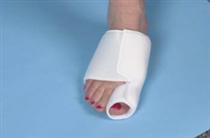Overview
 What most people call a bunion is actually known as "Hallux valgus". Hallux valgus refers to the condition in which the big toe is angled excessively towards the second toe and a bunion is a symptom of the deformity. In a normal foot, the big toe and the long bone that leads up to it (the first metatarsal) are in a straight line. However, Hallux valgus occurs when the long foot bone veers towards your other foot and your big toes drifts towards your second toe. A bunion actually refers to the bony prominence on the side of the big toe. This can also form a large sac of fluid, known as a bursa, which can then become inflamed and sore.
What most people call a bunion is actually known as "Hallux valgus". Hallux valgus refers to the condition in which the big toe is angled excessively towards the second toe and a bunion is a symptom of the deformity. In a normal foot, the big toe and the long bone that leads up to it (the first metatarsal) are in a straight line. However, Hallux valgus occurs when the long foot bone veers towards your other foot and your big toes drifts towards your second toe. A bunion actually refers to the bony prominence on the side of the big toe. This can also form a large sac of fluid, known as a bursa, which can then become inflamed and sore.
Causes
You may get bunions if the way your foot is shaped puts too much pressure on your big toe joint. Because bunions can run in families, some experts believe that the inherited shape of the foot makes some people more likely to get them. Your foot rolls inward too much when you walk. A moderate amount of inward roll, or pronation, is normal. But damage and injury can happen with too much pronation. You have flat feet. You often wear shoes that are too tight. All of these may put pressure on the big toe joint. Over time, the constant pressure forces the big toe out of alignment, bending it toward the other toes.
Symptoms
Since the pain from a bunion is always aggravated by shoe wear, the symptoms will often depend on the type and size of shoes worn. The perception of pain or discomfort that people experience is quite varied. There are some individuals who have small bunions that are very uncomfortable. This limits their ability to wear shoes comfortably. On the other hand, some individuals may have quite significant deformities that are annoying but do not limit their activities in anyway.
Diagnosis
Clinical findings are usually specific. Acute circumferential intense pain, warmth, swelling, and redness suggest gouty arthritis (see Gout) or infectious arthritis (see Acute Infectious Arthritis), sometimes mandating examination of synovial fluid. If multiple joints are affected, gout or another systemic rheumatic disease should be considered. If clinical diagnosis of osteoarthritic synovitis is equivocal, x-rays are taken. Suggestive findings include joint space narrowing and bony spurs extending from the metatarsal head or sometimes from the base of the proximal phalanx. Periarticular erosions (Martel sign) seen on imaging studies suggest gout.
Non Surgical Treatment
If you suspect a bunion, it is essential that you confirm your suspicions by consulting with a podiatric physician. Don?t try to treat the problem yourself, even by using conservative measures. Many conditions have similar symptoms, and only a professional can tell the difference. Once a diagnosis is obtained, it is essential to begin treatment immediately. Your podiatric physician will advise you on the most effective means. If caught early enough, good foot care, shoes that fit properly, and/or orthoses may eliminate the need for any further intervention. Certain over-the-counter remedies, such as felt or foam pads, applied to specific areas of the foot to relieve pressure and friction, will protect the bunion. Elevating the foot and icing the area for 20 minutes an hour may help to relieve pain.

Surgical Treatment
In cases where joint pain and deformity are severe, joint replacement surgery may be recommended. This may particularly be recommended when arthritis is present in the joint. Surgery may be carried out under a local, regional or general anaesthetic. Most cases are performed as a day stay procedure. However, an overnight stay in hospital may be required if the surgery is more extensive. The type of surgery to be performed, the type of anaesthetic to be used and the expected hospital stay should be discussed with your surgeon prior to surgery.
Prevention
Choosing footwear that fits correctly, especially low heeled shoes with plenty of space for the toes, is one of the main ways that bunions can be prevented. Always stand when trying on shoes to ensure they still fit comfortably when the foot expands under your body weight. Try shoes on both feet, and select the size appropriate for your larger foot. Use an extra insole if one shoe is looser than the other. Do not cramp the larger foot. People prone to flat-footedness should consider the use of arch supports, orthotic shoe inserts or special orthotic shoes to prevent or delay the development of bunions.
文章定位:



